How to Open A Mortice Lock Without A Key? Five Effective Methods
This article delves into the intricacies of opening a mortice lock without a key – a scenario that might arise during lockouts or lost key situations.
Introduction
Mortice locks are a staple in the security world, renowned for their robustness and reliability. Commonly found in hotel, residential, and commercial properties, these locks are embedded within the door, offering a higher level of protection than their surface-mounted counterparts.
This article delves into the intricacies of opening a mortice lock without a key – a scenario that might arise during lockouts or lost key situations.
However, it’s crucial to approach this topic with a clear understanding of legal and ethical considerations. Unauthorized tampering with locks can lead to legal repercussions and should only be attempted when lawful and necessary.
Prepare Tools for Opening a Mortice Lock
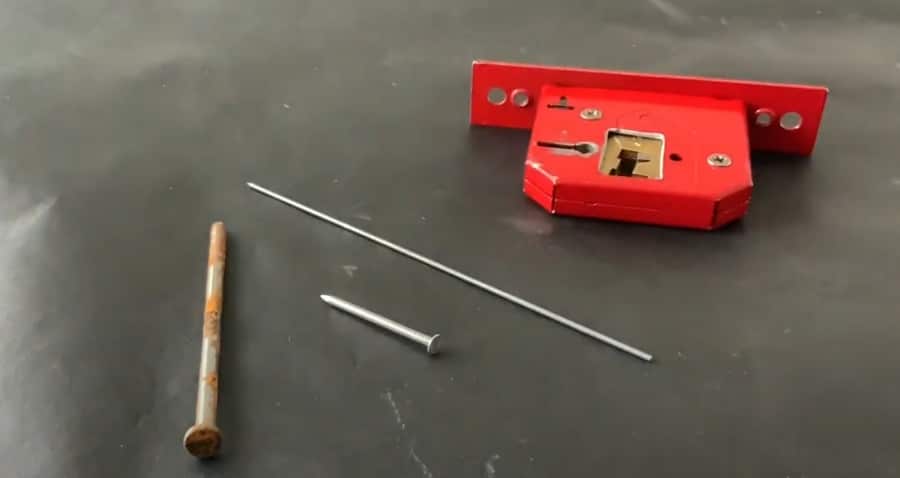
Navigating the challenge of a locked mortice without its key requires skill, patience, and the right tools. Using the appropriate tools makes the task more manageable and minimizes the risk of damaging the lock or the door.
- Screwdriver: A versatile tool, a screwdriver can manipulate the lock’s internal mechanism. Flat-head screwdrivers are often preferred due to their thin and flat tip, which can fit into the keyhole.
- Credit Card: While more commonly associated with bypassing latch-based locks, a sturdy credit card or a similar plastic card can sometimes be maneuvered to open simpler mortice locks.
- Bobby Pins and Paperclips: These everyday items can be bent and modified to act as makeshift lock picks. They’re especially useful for raking the pins inside the lock.
- Mortice Lock Pick Set: This is a specialized set of tools designed specifically for mortice locks. It comes in various shapes and sizes to fit different lock designs.
- Tension Wrench: This tool applies tension to the lock’s plug, holding the pins in place once they’ve been set.
- Drill: In situations where the lock needs to be entirely bypassed, a drill can destroy the lock mechanism, granting access. This method, however, renders the lock unusable and is typically a last resort.
In conclusion, while various tools are available for opening mortice locks, understanding the lock’s specific requirements and using the appropriate tools is crucial. This ensures a smooth, damage-free, and efficient unlocking process.
Method 1: Using a Credit Card
While the credit card technique is more commonly associated with bypassing simple latch-based locks, it can sometimes be effective on certain mortgage locks, especially those with a less complex mechanism. Here’s a step-by-step guide on how to use a credit card to open a mortice lock:
- Choose the Right Card: Using a card you’re not afraid to damage is essential, as this method can sometimes bend or scratch the card. An expired credit card or a similar plastic card would be ideal.
- Insert the Card: Position the card between the door frame and the door adjacent to the latch of the mortice lock. The magnetic strip should face the door, and the card should be perpendicular.
- Apply Pressure: Push and wiggle the card towards the latch, applying a bit of pressure. The aim is to slide the card over the latch, pushing it back into the door and allowing it to open.
- Slide and Open: As you feel the latch being pushed back by the card, begin to slide the card downwards while turning the door handle. This combined motion should push the latch out of the way, allowing the door to open.
- Alternate Method: If the direct approach doesn’t work, you can angle the card slightly towards the ground, wiggle, and slide it. This change in angle might give you better leverage against the latch.
- Considerations: It’s worth noting that this method might not work on all mortice locks, especially those with complex mechanisms or additional security features. It’s more likely to be effective on simpler locks or internal doors with less robust security.
Remember, while the credit card technique can be a handy trick in emergencies, using it responsibly and ethically is essential. Unauthorized or malicious use of this method is illegal and unethical. Always ensure you have the right to access the locked space before attempting any lock-picking techniques.
Opening a locked hotel mortise door with a credit card
Method 2: Using a Screwdriver
While a bit more involved than the credit card method, the screwdriver technique can be effective in opening certain mortice locks, especially if they’re older or have simpler mechanisms. Here’s how to use a screwdriver to open a mortice lock:
Instructions:
- Select the Right Screwdriver: Choose a flat-head screwdriver that fits snugly into the keyhole of the mortice lock. It shouldn’t be too large or too small; a tight fit is essential for this method to work.
- Insert the Screwdriver: Gently insert the screwdriver into the lock’s keyhole, ensuring it goes as deep as a regular key.
- Apply Tension: Once the screwdriver is in place, apply a slight turning pressure in the direction the key would turn to unlock the door. This tension will be necessary to manipulate the lock’s internal mechanism.
- Feel for the Mechanism: As you apply tension, try to feel the internal pins or levers of the lock. The aim is to align them in a position that allows the lock to turn.
- Manipulate and Turn: Gently jiggle the screwdriver up and down while maintaining the turning pressure. The idea is to mimic the action of a key, aligning the internal mechanisms to unlock the door. If you feel the screwdriver turning more freely at any point, it might mean the lock is disengaging.
- Open the Door: Once the lock turns, gently turn the door handle and push the door open.
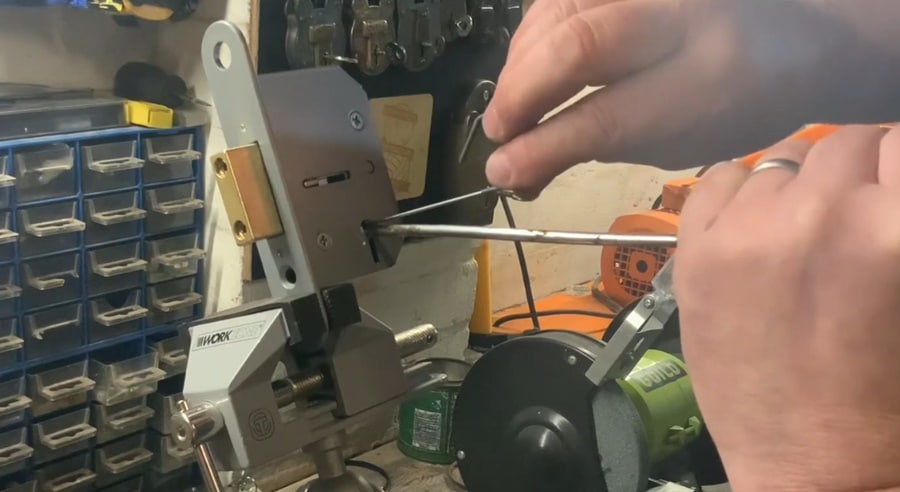
Precautions:
- Avoid Excessive Force: Too much force can damage the lock or the screwdriver. Always use gentle, controlled movements.
- Be Patient: This method requires patience and might take several attempts, especially if you’re unfamiliar with the lock’s internal structure.
- Check the Lock Type: Not all mortice locks can be opened with a screwdriver. Some modern locks have additional security features that prevent such methods.
- Professional Help: If you cannot open the lock after multiple attempts or are concerned about potential damage, consider seeking professional help from a locksmith.
In conclusion, while the screwdriver technique can be useful for opening certain mortice locks, it’s essential to approach the task with patience, care, and a clear understanding of the associated risks and responsibilities.
Method 3: Using Bobby Pin/Paperclip
Due to their malleability and slender design, Bobby pins and paperclips have been popularly portrayed in media as handy lock-picking tools. While they might not be as effective as professional lock-picking tools, with patience and technique, they can be used to tackle simpler locks. Here’s how to use them to open a mortice lock:
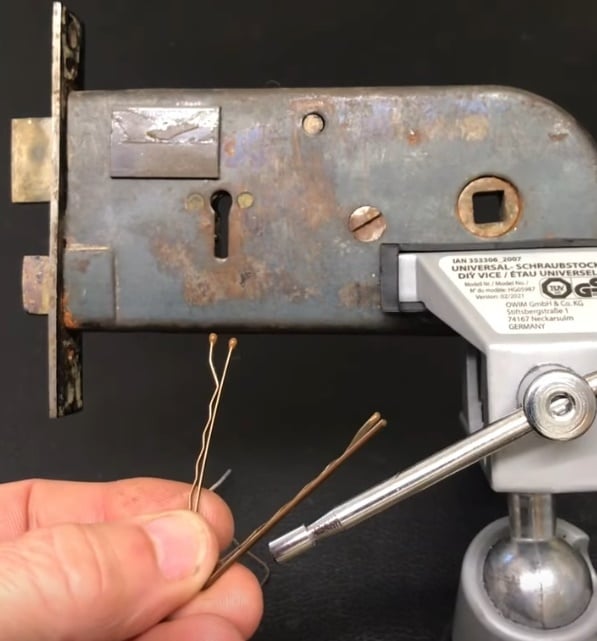
- Prepare the Tool:
- Bobby Pin: Straighten the bobby pin, leaving a small hook at one end. This hook will be used to manipulate the lock’s internal pins.
- Paperclip: Unfold the paperclip into a straight wire, creating a small hook similar to the bobby pin.
- Insert the Tool: Gently insert the straight end of your chosen tool into the lock’s keyhole, pushing it as deep as you can.
- Feel the Mechanism: With the tool inside, feel for the lock’s pins or levers. The key would typically align these small, spring-loaded mechanisms to unlock the door.
- Apply Gentle Pressure: Using the hook end of the tool, apply a slight upward pressure on each pin or lever, mimicking the action of a key. You’ll need to move the tool back and forth inside the keyhole to set each pin in place.
- Turn the Lock: While manipulating the pins, use another tool (bobby pin or paperclip) bent into an ‘L’ shape to apply to turn the pressure on the lock, like turning a key. If the pins are set correctly, the lock should turn.
- Open the Door: Once you feel the lock disengage, turn the door handle and push the door open.
Tips and Tricks:
- Two-Tool Approach: Using two tools simultaneously—one for turning the lock and the other for setting the pins—can make the process more manageable.
- Practice: If you’re keen on mastering this method, consider practicing on an old lock. Familiarity with the feel of pins and levers can be beneficial.
- Tactile Feedback: Pay close attention to the tool’s feedback. Feeling a slight movement or hearing a soft click can indicate that a pin has been set correctly.
- Be Gentle: Avoid using excessive force, which can damage the lock or your tools. Gentle, controlled movements are key.
In essence, while bobby pins and paperclips can be makeshift tools for lock-picking, their effectiveness largely depends on the user’s skill, the complexity of the lock, and a bit of patience.
How to pick open an Old Victorian mortice single lever lock with bobby pins
Method 4: Using Mortice Lock Pick Set
A Mortice Lock Pick Set is a specialized toolkit designed explicitly for the intricacies of mortice locks. Unlike standard pin tumbler locks, mortice locks often have a more complex mechanism, which requires a unique set of tools for successful picking.
A Mortice Lock Pick Set typically contains a variety of picks and tension tools tailored to fit mortice lock configurations. These tools are designed to manipulate the lock’s levers, wards, or other mechanisms without the original key.
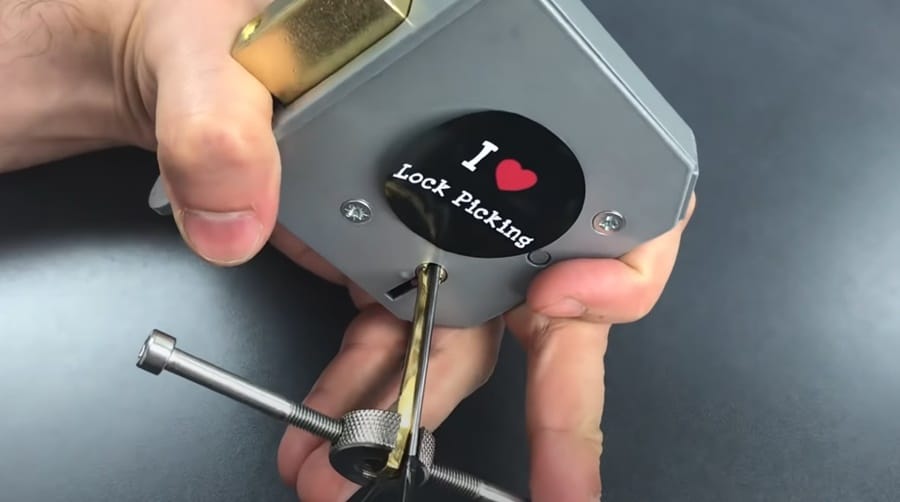
Components of a Mortice Lock Pick Set:
- Lever Picks: These are designed to lift, manipulate, and set the levers inside the lock to the correct height, allowing the bolt to move.
- Curtain Picks: Some mortice locks have a curtain (a rotating disc) that obstructs direct access to the levers. Curtain picks are designed to navigate around or through this curtain.
- Tension Tools: These apply turning pressure to the lock, simulating the action of a key turning. They often come in various sizes and shapes to fit different mortice lock profiles.
- Overlifters: These tools are designed to lift all the levers in the lock simultaneously, allowing for quicker manipulation.
How to Use a Mortice Lock Pick Set Effectively:
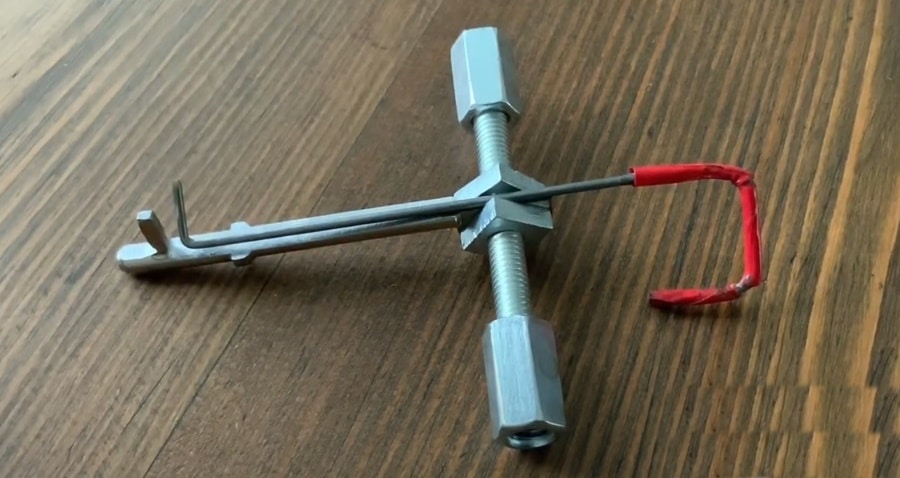
- Choose the Right Tool: Select the appropriate pick and tension tool for the specific lock you’re working on. The choice often depends on the lock’s design and the number of levers.
- Insert the Tension Tool: Place the tension tool into the keyway and apply slight turning pressure in the direction the key would turn. This tension will hold the levers in place once they’re set at the correct height.
- Begin Picking: Insert your chosen pick into the lock. Gently feel for the levers and start manipulating them one by one. The aim is to lift each lever to its correct height, allowing the bolt to move.
- Listen and Feel: As you manipulate the levers, notice any clicks or movements. These can indicate that a lever has been correctly set.
- Adjust Tension: The amount of tension you apply can make a difference. If you’re struggling to set the levers, consider adjusting the tension slightly.
- Practice: Like all lock-picking techniques, mastering a Mortice Lock Pick Set requires practice. Work on different types of mortice locks to gain experience and improve your skills.
In conclusion, a Mortice Lock Pick Set is an invaluable toolkit for anyone looking to tackle the complexities of mortice locks. With patience, practice, and the right techniques, these tools can effectively navigate and open a wide range of mortice lock designs.
Method 5: Drill Open a Mortice Lock – A Last-Resort Method
Drilling is another destructive method used to gain entry when other methods fail. It involves drilling directly into the lock mechanism to turn it off.
- Choose the Right Drill Bit: A hard, durable drill bit, preferably made of tungsten carbide or cobalt, is essential to penetrate the lock’s metal components.
- Mark the Drill Point: Identify where the levers or pins are located on the lock. This is typically just above the keyway. Mark this point with a marker or punch.
- Start Drilling: Begin drilling slowly to ensure accuracy. The aim is to drill through the pins or levers, rendering them ineffective.
- Deepen the Hole: As you drill, you may need to go deeper to reach all the pins or levers. Periodically stop and try turning the lock with a screwdriver to see if it has been disengaged.
- Clean the Keyway: Once you’ve drilled through the necessary components, clear out any debris from the keyway using a screwdriver or pick.
- Turn and Open: Insert a flat-head screwdriver into the keyway and turn. The lock should disengage, allowing you to open the door.
Implications:
- Lock Replacement: The lock will be rendered unusable and replaced after drilling.
- Potential Door Damage: Drilling can damage the lock and the door, especially if done incorrectly.
- Cost: Replacing a lock and potentially repairing door damage can be costly.
- Security Concerns: Until the lock is replaced, the security of the property will be compromised.
- Legal and Ethical Considerations: As with any lock-picking or breaking method, ensure you have the right to access the locked space. Unauthorized entry, even with the best intentions, is illegal and unethical.
In conclusion, while breaking into or drilling open a mortice lock can be effective methods of last resort, they come with significant implications. It’s always advisable to consider non-destructive methods first or seek professional assistance from a locksmith.
Unlocking UK Lever Lock Locksmith Lock Opening by Drilling
How to Open a 5-Lever Mortise Lock Without a Key?
5-lever mortise locks are among the more secure variations of mortise locks, often used in external doors and areas requiring enhanced security. The “5-lever” designation indicates that the lock contains five levers that must be correctly aligned to allow the bolt to retract.
- Lever Lock Picking:
- Tools Needed: A 5-lever lock pick set includes specialized picks and tension tools tailored for such locks.
- Method: Insert the tension tool and apply slight turning pressure. Using the pick, manipulate each of the five levers individually, setting them to the correct height. Listen for subtle clicks or changes in resistance, which can indicate a lever is set correctly.
- Over lifting:
- Tools Needed: An over-lifter tool designed to lift all the levers simultaneously.
- Method: Insert the over-lifter into the lock and lift all the levers simultaneously. Turn the lock using a tension tool while maintaining upward pressure on the levers. This method can be quicker but might not work on all 5-lever locks, especially those with anti-pick features.
In summary, 5-lever mortise locks offer enhanced security but are not impervious. They can be successfully navigated with the right tools, techniques, and approaches.
Five-lever Mortice lock picked using a screwdriver as a tension tool
How to Open a 3-Lever Door Lock Without a Key?
3-lever mortise locks are a simpler variant compared to their 5-lever counterparts. As the name suggests, they contain three levers that must be aligned correctly to allow the bolt to retract. While they offer a decent level of security, they are generally considered less secure than 5-lever locks and are often found on internal doors or in areas with lower security requirements.
- Lever Lock Picking:
- Tools Needed: A 3-lever lock pick set.
- Method: Like the 5-lever technique, insert the tension tool and apply a slight turning pressure. Using the pick, manipulate each of the three levers individually. With fewer levers, this process can be quicker and simpler than picking a 5-lever lock.
- Over lifting:
- Tools Needed: An over-lifter tool suitable for 3-lever locks.
- Method: Insert the powerlifter and lift all the levers simultaneously. While maintaining the upward pressure, turn the lock using a tension tool.
In conclusion, 3-lever door locks are simpler than 5-lever locks, but they still require skill and the right tools to open without a key. Understanding the differences and nuances between the two can help you choose the right approach and tools for the task.
How to pick a simple 3-lever mortice lock with homemade tools?
Troubleshooting and Maintenance
A mortise lock getting stuck in a locked position can be a frustrating experience. Here are some solutions and steps to address the issue:
- Lubricate the Lock: Over time, dirt and grime can accumulate inside the lock, causing it to jam. Spray a lubricant like WD-40 into the keyhole and let it sit for a few minutes before trying the key again.
- Check the Key: Ensure you’re using the correct key and that it isn’t bent or damaged. A worn-out key might not engage the lock’s mechanism properly.
- Inspect the Door Alignment: Doors can shift over time due to changes in temperature and humidity. If the door isn’t aligned correctly with the frame, it can put pressure on the lock, causing it to jam. Adjusting the door or the strike plate might resolve the issue.
- Gently Tap the Lock: Sometimes, a gentle tap around the lock using a mallet can help dislodge any internal components that might be stuck.
- Seek Professional Help: If the lock remains stuck after trying the above solutions, it’s best to call a locksmith to avoid causing further damage.
In conclusion, regular maintenance, understanding the intricacies of mortice locks, and taking timely action can ensure these locks’ smooth operation and security. Whether troubleshooting a problem or enhancing security, it’s essential to approach tasks with knowledge and care.
Conclusion
Mortice locks, with their intricate design and robust security features, have been a staple in safeguarding homes and establishments for many years. Throughout this guide, we’ve delved into the nuances of these locks, from understanding their mechanism to exploring various techniques for tackling them without a key.
Moreover, while DIY methods can be handy in emergencies or for enthusiasts, there’s no substitute for professional expertise. Locksmiths possess the skills, tools, and experience to handle lock-related challenges efficiently and safely. If in doubt or facing a particularly challenging lock, it’s always best to seek professional intervention.

